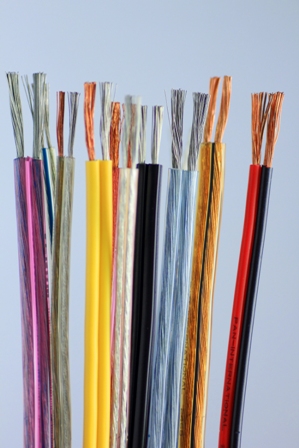XLPE - cross-linked polyethylene
XLPE is an abbreviated
designation of “cross-linked polyethylene”. Polyethylene has a linear molecular
structure as shown in A. Molecules of polyethylene not chemically bonded as
shown in B are easily deformed at high temperature, while XLPE molecules
bonded in a three dimensional network as shown in C and D, have strong
resistance to deformation even at high temperature.
Cross linked polyethylene is produced from polyethylene under high pressure
with organic peroxides as additives. The application of heat and pressure is
used to effect the cross linking. This causes the individual molecular chains
to link with one another which in turn causes the material to change from a
thermoplastic to an elastic material.
An important advantage of XLPE as insulation for medium and
high voltage cables is their low dielectric loss. The dielectric loss factor is
about one decimal power lower than that of paper insulated cables and about two
decimal powers lower than that of PVC-insulated cables. Since the dielectric
constant is also more favourable, the mutual capacitance of XLPE cables is also
lower, thus reducing the charging currents and earth-leakage currents in
networks without the rigid star-point earthing.
“XLPE” Insulation
Offers These Advantages:
·
Outstanding
physical and mechanical toughness
·
Extremely low
moisture absorption
·
Excellent ozone
resistance
·
Strong
resistance to chemicals fumes and gases
·
Low SIC and
power factor
·
High impulsed
strength
·
High insulation
resistance and dielectric strength
·
Capability of
carrying and terminating
·
Easy to splicing
and terminating
Below is commonly use UL Style for XLPE insulated hook up wire.
UL3386 105ºC 600V XLPE
INSULATED WIRE
Halogen Free
·
Rated temperature:105ºC·
· Rated voltage: 600v
·
According to:UL subject 758, UL1581, CSA
C22.2
·
Solid or Stranded, Tinned or bare
copper conductor 32~8AWG
·
XLPE insulation
·
Passes UL VW-1 &
CSA FT1 Vertical flame test
·
Uniform insulation
thickness of wire to ensure easy stripping and cutting.
·
RoHS Compliant.
·
UL3386 wire can use
for the Internal wiring of appliances where exposed to oil at a temperature not
exceeding (60°C or 80°C, whichever is applicable).
|
Gauge(AWG)
|
Copper (mm)
|
Conductor OD (mm)
|
insulation thickness
(mm)
|
wire O.D
(mm)
|
Max Cond. resistance(Ω/kft ,20ºC)
|
|
26
|
7/0.16
|
0.48
|
0.76
|
2.10±0.1
|
45.2
|
|
24
|
11/0.16
|
0.61
|
2.25±0.1
|
29.3
|
|
22
|
17/0.16
|
0.76
|
2.35±0.1
|
16.7
|
|
20
|
21/0.178
|
0.94
|
2.55±0.1
|
10.5
|
|
18
|
16/0.254
|
1.16
|
2.80±0.1
|
6.52
|
|
16
|
26/0.254
|
1.49
|
3.10±0.1
|
4.18
|
|
14
|
41/0.254
|
1.87
|
3.77±0.1
|
2.62
|
|
12
|
65/0.254
|
2.36
|
4.14±0.1
|
1.65
|
|
10
|
105/0.254
|
3
|
5.20±0.1
|
1.04
|
|
8
|
119/0.3
|
4.25
|
1.14
|
6.90±0.2
|
0.653
|
UL3271 Specification
APPLIANCE WIRING MATERIAL
Subj.758
Section 3
Page 3271
Issued:1972-08-02
Revised:2011-10-04
Style 3271
Single conductor with extruded sulation.
|
Rating
|
125 deg C,
600 Vac, 750 Vdc, Horizontal flame.
|
|
Conductor
|
30 AWG -
1000 kcmil solid, stranded, or braided, tinned, bare or silver-plated
copper or
solid or stranded coated high strength copper - minimum 90 percent
conductivity.
|
|
Insulation
|
Extruded
XLPE.
|
|
Conductor
size
|
Minimum
average thickness
|
Minimum
thickness at any point
|
|
30-9 AWG
|
30 mils
|
27 mils
|
|
8-2 AWG
|
45 mils
|
40 mils
|
|
1-4/0 AWG
|
55 mils
|
50 mils
|
|
213-500
kcmil
|
65 mils
|
58 mils
|
|
501-1000
kcmil
|
80 mils
|
72 mils
|
|
1001-2000
kcmil
|
95 mils
|
86 mils
|
|
|
Standard
|
Appliance
Wiring Material UL 758.
|
|
Marking
|
General.
|
|
Use
|
For use as
Motor Leads or Internal Wiring of appliances. Tags may indicate the
following: 2500 volt peak - For Electronic Use Only.
|

